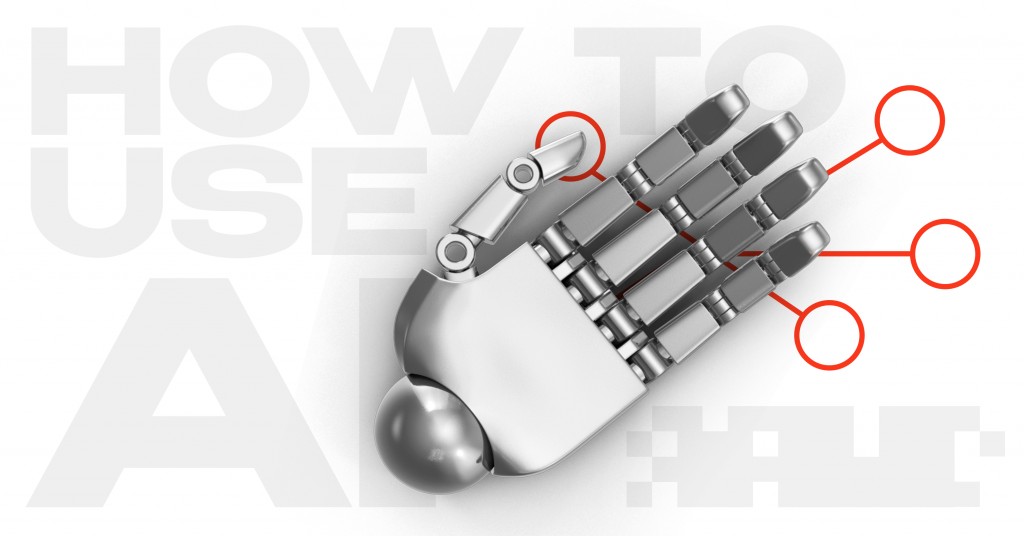How to Use AI in Mobile Applications Development?

Artificial Intelligence in apps is not only a powerful tool for various purposes, but it’s also an exciting and emerging field in the business world. With AI-powered technology becoming increasingly popular across industries from education to the finance sector or medicine, there are many projects that decide to specifically create a mobile artificial intelligence app to achieve faster data gathering and its further processing to maximize profits and customers’ satisfaction.
It has the potential to grow exponentially, so plenty of startups are not going to miss out on such a big opportunity. According to Statista, AI’s global market value will exceed $89 billion by 2025. So now is the right moment to focus on innovation.
Benefits of Artificial Intelligence in mobile applications
Speaking about AI’s general description, the ability of a system to copy intelligent behavior and decide without human input is usually mentioned. It falls under computer science which studies how computers deal with any kind of tasks commonly requiring higher cognitive functioning such as reasoning or learning new things.
Trends in the mobile sector are shifting, resulting in increased expectations for users who want personalized experiences across all platforms. Apps must meet these standards if they hope to maintain their popularity among consumers who have got a lot of options to choose from.
As such individualized and predictive interaction is a priority for the majority of client-oriented businesses, AI’s main benefits include:
Fast learning of user behavior pattern
As the demands are growing as innovation advances, people are waiting for a unique, individualized journey based on previous purchases, favorites, and recently viewed products. AI is a key to better UX when it comes to analyzing such information. Managers had to prioritize potential clients manually and personally decide to whom and what to offer. Fortunately, AI performs it within seconds, studying activities and identifying target audiences.

Use of neural networks
Neural networks are a subset of machine learning (ML) when robots basically receive any kind of data and teach themselves based on it. These days, it is highly demanded for speech synthesizing, behavior predicting, automatic data identification and message classification, faces/signals/images recognition, etc.
Google and Microsoft have upgraded their translation apps with NN by releasing AI-powered offline versions. Facebook has already shown its ability to recognize people on photos by suggesting to tag them.
Why do you need ML for your type of project? While a hand-coded program requires specific instructions to complete a task, ML learns to recognize patterns on its own to predict the next step. The whole development process and app’s further maintenance become faster, smarter, and cost-efficient.
Smart search
AI has introduced a new manner for visitors to be suggested while searching for particular objects. The combination of ML and image identification elevated the consumer experience to never-seen-before heights, especially when voice recognition was implemented. Asking Google for anything online has never been easier.
Conversational UI
The interactive UI function is a perfect instrument that would help consumers to effectively communicate with your product on their terms. Although speech recognition has been around for a while, the conversational UI makes it more robust. Accounting and finance firms incorporate this innovation and communicate with clients via text and voice messaging. Transactions, purchases, and other in-app actions are all studied to give financial recommendations. And it’s not only limited to business-related products: now it has been widely utilized in healthcare, entertainment, etc. taking customer support to a brand new level.

Real-time translation
In today’s globalized world where people from different areas come together on an everyday basis, there has been a growing need for translation tools and their instant accessibility. From virtual assistants to in-ear buds, the latest AI-powered solutions provide a simultaneous interpretation of speech in two languages, guaranteeing an accurate rendition without any lag time or fuzzy sound equality. No matter where you are located, whether it’s another country or you are sitting next to someone speaking their native tongue – you will be able to understand everything without issues.
Sounds unrealistic? In 2020, a Chinese giant Alibaba did something pretty cool – they streamed the first-ever session with RTT where Chinese was translated into English, Spanish, etc. Moreover, the system was dealing with specific unusual accents, slang words in a pretty noisy room. To improve robots’ understanding of specific phrases, they have developed an innovative in-house solution that helps machines hear what is said to them through their more intelligent model. It was done by basically incorporating visual information recognition. Thus, informal sentences were reworded into formal ones as they would be used by someone speaking more officially than one who uses slang language often heard on television shows or movies.

Monotonous tasks completed faster
Marketers must gather and examine enormous amounts of info for planning a strategy to drive sales. Maintaining consumer data requires an inordinate amount of time as well. Apps that use AI quickly analyze such amounts of data to evaluate user activities and make super-fast choices. As a result, instead of the usual long multipurpose strategy planning, manual visitors behavior analysis, and the whole marketing department involvement, such an AI-powered app gets all the necessary info by itself giving relevant suggestions.
Moreover, chances of mistakes typical for human activity are tiny: with AI implementation, such issues get solved.
Face unlock capabilities
In the race for biometric innovation, several projects are fighting for the gold medal. Google, Apple, Facebook, Microsoft regularly let us know about their latest discoveries in image recognition and face analysis.
Besides typical face unlock in our phones, this feature is widely implemented in other areas.
With the Face Match, a specific visitor is identified by scanning his facial features, if it matches recorded images on the database, access is granted.
Biometric security systems are used as a replacement for PINs/passwords. Biometrics takes an individual’s unique physical traits, i.e. fingerprints or facial scans, to identify them instead of relying on insecure methods that can easily be stolen (both physically and electronically). With face recognition, customers can log into accounts with a quick glance. If an imposter tries to do the same, it will immediately be revealed/blocked!
First finance fraud prevention systems are being deployed at the biggest banks to protect their workers and clients. A new algorithm uses AI along with image databases to recognize potential scammers before they cause any harm!
Forecasting marketing
Want to predict the amount and type of products/services that will be purchased in advance? Machine learning algorithms on collected data help to improve sales forecasts so companies can plan better with confidence!
Such an approach allows to accelerate data processing, provides more accurate forecasts thanks to an ability to automate changes based on the latest data. By identifying hidden patterns throughout the history of past sales or other factors like seasonal trends this type of technology can help companies make smarter marketing decisions.
Is it worth investing in this new approach? Numbers speak for themselves: the market for AI in marketing is forecasted to hit $107 million by 2028. Just to compare, the global sector was valued at 12,044.46 million last year and numbers will continue to grow rapidly.
Improved app authentication
The future of stronger cyber defense is in high demand as AI-powered attacks seem inevitable. These systems will need to be updated and improved with each new trend automatically, or they could fall behind the hackers’ progression.
Now we will be patiently waiting for a time when authentication becomes even more convenient, with the use of AI and biometric technology for added security. This will not only allow people not to worry about their data anymore but also send alerts on any possible threats that may come up during any interaction or transaction process.
Automated reasoning
It is a must for food delivery or taxi app to find the fastest way to get to the “B” point. It’s now possible to develop applications with a certain ‘living person’ competence by empowering programs with reasoning for themselves rather than having any real live human interaction.
One example that could summarize this scenario would be Uber and how it’s been able to improve its service with the help of artificial intelligence. Uber is using automated reasoning to find the shortest path to drop users faster based on the time of the day or current traffic problems. The system takes data from all of its drivers who have previously taken trips with similar locations and are familiar with the road and uses that information to analyze patterns and offer better results.
AI Technologies used in Mobile Apps
Machine Learning
Machine learning is a really cool technology that can be found working in many apps. It’s one of those things you might not even know exists until your favorite app has been completely transformed by its integration!
Incorporating ML into your product will help to improve business processes and increase productivity by automating simple tasks previously done by humans like data entry, forecasting, and big amounts of data analysis.
Speech Recognition Technology
With examples like Siri and Cortana that decode human speech into computer-readable formats, you can control your device with just voice commands! Plenty of apps implement this feature today to make our lives easier.
Natural Language Technology
It is the perfect fit for apps that need to do more than just answer a few questions and send out emails. Natural language technology can create reports, market reviews, and even generate new ideas by summarizing texts.
Biometrics
It identifies human behavior and encompasses physical aspects such as an object’s shape or size to more complex factors like who exactly walks into the room before they even speak!
Biometrics has become a popular marketing instrument to authenticate customers. For instance, biometric technology analyzes store visitors’ voices allowing owners to improve targeting and marketing actions. It recognizes gestures like pointing or waving which is for better customers’ behavior analysis.
Chatbots
When interacting with your clients, chatbots are the virtual assistant for your company that answers any question with ease. Some companies that successfully use and love chatbots include Apple, Amazon, and more!
Bots do not only talk and listen without actual human interaction but also analyze what’s being said or asked and automate things like giving details about an order, changing its details, sending info about a callback, etc.
Emotion recognition
An interesting instrument to analyze human emotions from their face. With the help of advanced image processing or audio data for emotion recognition, it allows capturing the subtleties of speech to determine what someone might be feeling at any given moment with perfect accuracy.
Image recognition
It is a powerful tool in the world of digital marketing created for everything from identifying license plates to recognizing faces and checking consumers by their preferences during checkout processes on apps.
Text recognition
Natural language processing is helpful in fraud detection and security. In the future, it could be applied to all sorts of things from searching for information on Google or reading articles more efficiently. It would be able to summarize text by recognizing entities, numbers, and names which would automate categorization tasks like grouping similar items together, understanding complex sentences, etc.
Conclusion
Artificial intelligence in apps improves flexibility and also has the potential to drive digital transformation to greater levels. A good AI-oriented app and web development company understands that it greatly helps digital businesses with customer experience improvement by allowing companies to collect and analyze consumer data faster. It assists enterprises in resolving complicated and monotonous tasks rapidly and establishes a higher level of performance compared to older instruments with direct human interaction.
